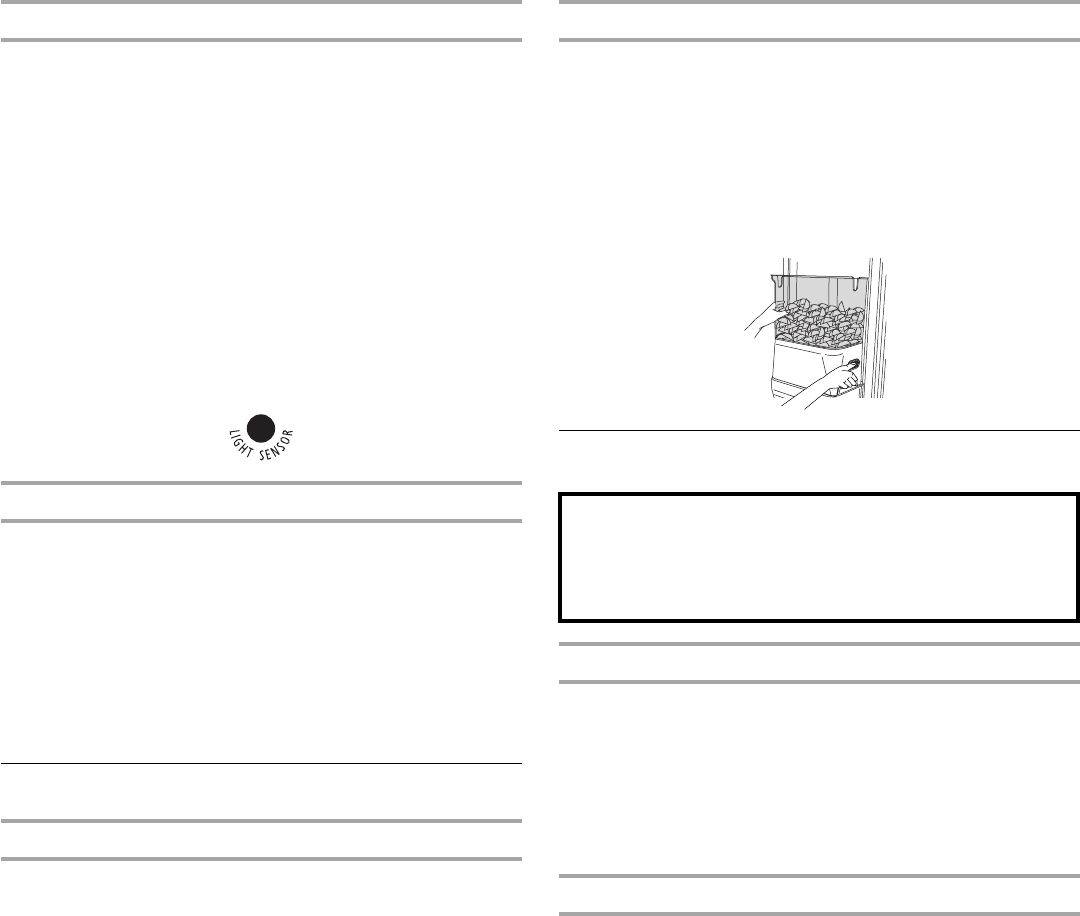
5
The Dispenser Light
Style 1: The dispenser light can be turned on by pressing the ON
button.
Style 2: When you use the dispenser, the lever will automatically
turn the light on. If you want the light to be on continuously, you
may choose either ON or NIGHT LIGHT.
ON: Press the LIGHT button to turn on the dispenser light.
NIGHT LIGHT: Press the LIGHT button a second time to select
the Night Light. The dispenser light will automatically adjust to
become brighter as the room brightens, dimmer as the room
darkens.
OFF: Press the LIGHT button a third time to turn off the dispenser
light.
The dispenser lights are LEDs which should not need to be
changed. If it appears that your dispenser lights are not working,
be sure that the light sensor is not blocked (in Night Light mode).
See “Troubleshooting” for more information.
The Dispenser Lock (on some models)
The dispenser can be turned off for easy cleaning or to avoid
unintentional dispensing by small children and pets.
NOTE: The lock feature does not shut off power to the product,
to the ice maker, or to the dispenser light. It simply deactivates
the dispenser levers. The ice and water dispensers will not work.
Style 1: Press the LOCK button to lock the dispenser. Press the
UNLOCK button to unlock the dispenser.
Style 2: Press and hold the LOCK OUT button to lock the
dispenser. Press and hold the LOCK OUT button a second time
to unlock the dispenser.
Ice Maker and Storage Bin
Turning the Ice Maker On/Off
The On/Off switch is located on the top right-hand side of the
freezer compartment.
To turn on the ice maker, slide the control to the ON (left) position.
To manually turn off the ice maker, slide the control to the OFF
(right) position.
NOTE: Your ice maker has an automatic shutoff. The ice maker
sensors will automatically stop ice production, but the control will
remain in the ON (left) position.
REMEMBER:
■ Allow 24 hours to produce the first batch of ice. Discard the
first three batches of ice produced.
■ The quality of your ice will be only as good as the quality of
the water supplied to your ice maker. Avoid connecting the
ice maker to a softened water supply. Water softener
chemicals (such as salt) can damage parts of the ice maker
and lead to poor quality ice. If a softened water supply cannot
be avoided, make sure the water softener is operating
properly and is well maintained.
■ Do not use anything sharp to break up the ice in the storage
bin. This can cause damage to the ice container and the
dispenser mechanism.
■ Do not store anything on top of or in the ice maker or storage
bin.
Removing and Replacing Ice Storage Bin
1. Hold the base of the storage bin with both hands and press
the release button to lift the storage bin up and out.
NOTE: It is not necessary to turn the ice maker control to the
OFF (right) position when removing the storage bin. The
sensor cover (“flipper door”) on the left wall of the freezer
stops the ice maker from producing ice if the door is open or
the storage bin is removed.
2. Replace the storage bin on the door and push down to make
sure it is securely in place.
Water Filtration System
Water Filter Status Display (on some models)
The filter status display will help you know when to change your
water filter. When the display reads 10%, order a new filter. It is
recommended that you replace the filter when the display reads
0% OR when water flow to your water dispenser or ice maker
decreases noticeably. The filter should be replaced at least every
6 months depending on your water quality and usage.
After changing the filter, reset the display by pressing the button.
The display will read 99% when the system is reset.
Non-Indicator Water Filter (on some models)
If your refrigerator does not have the water filter status light, you
should change the water filter cartridge at least every 6 months
depending on your water quality and usage. If the water flow to
the water dispenser or ice maker decreases noticeably before
6 months have passed, replace the water filter more often.
Do not use with water that is microbiologically unsafe or
of unknown quality without adequate disinfection before
or after the system. Systems certified for cyst reduction
may be used on disinfected waters that may contain
filterable cysts.
